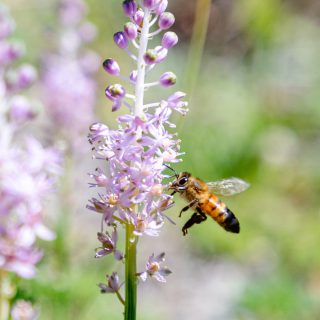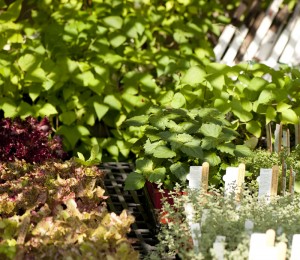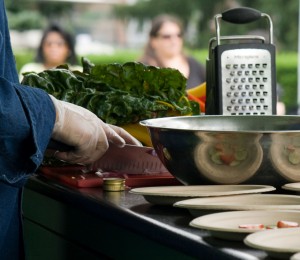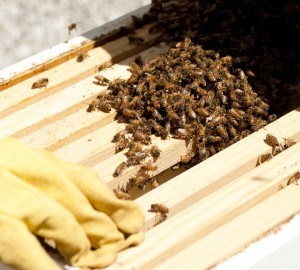Inside The New York Botanical Garden
Ann Novak
Posted in Around the Garden on October 7 2019, by Ann Novak
Annie Novak is the Manager of the Edible Academy at The New York Botanical Garden.
 We introduced our first pair of beehives to the Ruth Rea Howell Family Garden in 2010, the year beekeeping was re-legalized in New York City. We sited the apiaries—Langstroth hives—atop the single flat rooftop on our garden site, a one-story brick and concrete building home to both gardening and office equipment fondly called “the tool shed.” This gave our foraging worker bees zipping in and out of the hive a clear flight path above our vegetable plots, above and away from our visitors.
We introduced our first pair of beehives to the Ruth Rea Howell Family Garden in 2010, the year beekeeping was re-legalized in New York City. We sited the apiaries—Langstroth hives—atop the single flat rooftop on our garden site, a one-story brick and concrete building home to both gardening and office equipment fondly called “the tool shed.” This gave our foraging worker bees zipping in and out of the hive a clear flight path above our vegetable plots, above and away from our visitors.
With the opening of the Edible Academy campus in the spring of 2018, our beehives moved to a much better location: the Kate Solomon Family Apiary, a flat, staff-accessible platform adjacent to the Gossett Overlook Pavilion. Now at eye-level (at a safe distance), visitors can observe the honeybees more readily. Unsurprisingly, a frequent query is what we do with their honey.
Read More
Posted in Children's Education on May 26 2015, by Ann Novak
Ann Novak is the Manager of the Edible Academy at The New York Botanical Garden.
 Our lettuce transplants are getting bigger every day, snappy radish roots are turning red under the soil, and the peas are starting to vine. It’s time for Salad Days at the Ruth Rea Howell Family Garden! Shakespeare called a person’s youth “salad days” for a reason: these are the sweetest days of the year, when everything seems possible. Especially a delicious salad! We’re in our last week of this wonderful program, which ends on Friday, June 5.
Our lettuce transplants are getting bigger every day, snappy radish roots are turning red under the soil, and the peas are starting to vine. It’s time for Salad Days at the Ruth Rea Howell Family Garden! Shakespeare called a person’s youth “salad days” for a reason: these are the sweetest days of the year, when everything seems possible. Especially a delicious salad! We’re in our last week of this wonderful program, which ends on Friday, June 5.
To learn more about all the crops in our plots, dig in with the staff in the Family Garden. We’re excited about our first harvest of the season and celebrating salads in all sorts of ways. Visitors can create a paper plate salad to learn more about plant parts as we make art. Measure and mix the dried herbs you need to take home a salad dressing to finish and enjoy at home. Explore the garden with a scavenger hunt learning more about the plant parts that make up a salad.
Read More
Posted in Programs and Events on May 10 2012, by Ann Novak
As the founder and director of the Growing Chefs field-to-fork education program, co-founder of the Eagle Street Rooftop Farm, and the Assistant Manager of the Ruth Rea Howell Family Garden, Annie Novak knows her way around a vegetable plot. Join her on May 17 for The Art of Cooking in the French Garden, bringing the taste and sophistication of this world-renowned cuisine to the NYBG.
 Coq au vin, Quiche Lorraine, and vichyssoise—nowhere in the world have culinary artists developed such a reputation for precision, passion and talent as in the French kitchen. From perfectly crusty baguettes to finely flavored vinaigrettes, the art of French cooking seems at first glance like an unachievable alchemy of herbs, creams, and knife skills. But as a green thumb enamored with the precise and beautiful public parks throughout Paris (and a compulsive Googler of Versailles’ vegetable gardens), I became obsessed with the idea that French food could be done well, yet with ease.
Coq au vin, Quiche Lorraine, and vichyssoise—nowhere in the world have culinary artists developed such a reputation for precision, passion and talent as in the French kitchen. From perfectly crusty baguettes to finely flavored vinaigrettes, the art of French cooking seems at first glance like an unachievable alchemy of herbs, creams, and knife skills. But as a green thumb enamored with the precise and beautiful public parks throughout Paris (and a compulsive Googler of Versailles’ vegetable gardens), I became obsessed with the idea that French food could be done well, yet with ease.
Read More
Posted in Around the Garden on May 8 2012, by Ann Novak
Ed. Note: The beekeeping craze that’s sweeping New York City isn’t just for rooftops in Brooklyn! Annie Novak, Assistant Manager of the Ruth Rea Howell Family Garden, was kind enough to explain her most recent adventure giving bees a home at the NYBG.
 We installed the beehives on top of our garden shed space, so the bees have a clear flight path over the Garden site. As the hives’ populations grow, so do our vegetables. Thanks to the bees, we have higher rates of fruiting on our apple trees and pepper plants.
We installed the beehives on top of our garden shed space, so the bees have a clear flight path over the Garden site. As the hives’ populations grow, so do our vegetables. Thanks to the bees, we have higher rates of fruiting on our apple trees and pepper plants.
The bees spend the first part of the spring season building up wax combs to lay eggs in, as well as store honey later in the year. As the Family Garden grows, and the cherries and lilacs just outside the Family Garden bloom, we start to see our bees venture further afield. They’ll fly up to five miles from the hive to gather nectar and pollen, but with a campus as lush as the New York Botanical Garden, they don’t have to go that far to get food.
Read More
 We introduced our first pair of beehives to the Ruth Rea Howell Family Garden in 2010, the year beekeeping was re-legalized in New York City. We sited the apiaries—Langstroth hives—atop the single flat rooftop on our garden site, a one-story brick and concrete building home to both gardening and office equipment fondly called “the tool shed.” This gave our foraging worker bees zipping in and out of the hive a clear flight path above our vegetable plots, above and away from our visitors.
We introduced our first pair of beehives to the Ruth Rea Howell Family Garden in 2010, the year beekeeping was re-legalized in New York City. We sited the apiaries—Langstroth hives—atop the single flat rooftop on our garden site, a one-story brick and concrete building home to both gardening and office equipment fondly called “the tool shed.” This gave our foraging worker bees zipping in and out of the hive a clear flight path above our vegetable plots, above and away from our visitors. 


